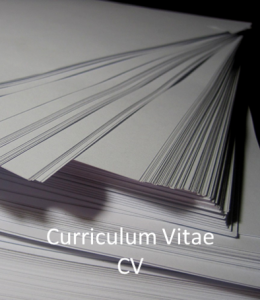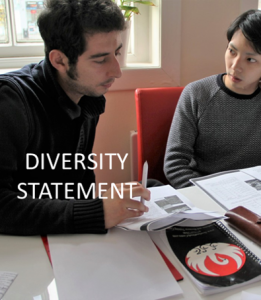The Purpose of a Research Statement
The main goal of a research statement is to walk the search committee through the evolution of your research, to highlight your research accomplishments, and to show where your research will be taking you next. To a certain extent, the next steps that you identify within your statement will also need to touch on how your research could benefit the institution to which you are applying. This might be in terms of grant money, faculty collaborations, involving students in your research, or developing new courses. Your CV will usually show a search committee where you have done your research, who your mentors have been, the titles of your various research projects, a list of your papers, and it may provide a very brief summary of what some of this research involves. However, there can be certain points of interest that a CV may not always address in enough detail.
- What got you interested in this research?
- What was the burning question that you set out to answer?
- What challenges did you encounter along the way, and how did you overcome these challenges?
- How can your research be applied?
- Why is your research important within your field?
- What direction will your research take you in next, and what new questions do you have?
While you may not have a good sense of where your research will ultimately lead you, you should have a sense of some of the possible destinations along the way. You want to be able to show a search committee that your research is moving forward and that you are moving forward along with it in terms of developing new skills and knowledge. Ultimately, your research statement should complement your cover letter, CV, and teaching philosophy to illustrate what makes you an ideal candidate for the job. The more clearly you can articulate the path your research has taken, and where it will take you in the future, the more convincing and interesting it will be to read.
Separate research statements are usually requested from researchers in engineering, social, physical, and life sciences, but can also be requested for researchers in the humanities. In many cases, however, the same information that is covered in the research statement is often integrated into the cover letter for many disciplines within the humanities and no separate research statement is requested within the job advertisement. Seek advice from current faculty and new hires about the conventions of your discipline if you are in doubt.
Timeline: Getting Started with your Research Statement
You can think of a research statement as having three distinct parts. The first part will focus on your past research, and can include the reasons you started your research, an explanation as to why the questions you originally asked are important in your field, and a summary some of the work you did to answer some of these early questions.
The middle part of the research statement focuses on your current research. How is this research different from previous work you have done, and what brought you to where you are today? You should still explain the questions you are trying to ask, and it is very important that you focus on some of the findings that you have (and cite some of the publications associated with these findings). In other words, do not talk about your research in abstract terms, make sure that you explain your actual results and findings (even if these may not be entirely complete when you are applying for faculty positions), and mention why these results are significant.
The final part of your research statement should build on the first two parts. Yes, you have asked good questions, and used good methods to find some answers, but how will you now use this foundation to take you into your future? Since you are hoping that your future will be at one of the institutions to which you are applying, you should provide some convincing reasons why your future research will be possible at each institution, and why it will be beneficial to that institution, or to the students at that institution.
While you are focusing on the past, present, and future or your research, and tailoring it to each institution, you should also think about the length of your statement and how detailed or specific you make the descriptions of your research. Think about who will be reading it. Will they all understand the jargon you are using? Are they experts in the subject, or experts in a range of related subjects? Can you go into very specific detail, or do you need to talk about your research in broader terms that make sense to people outside of your research field focusing on the common ground that might exist? Additionally, you should make sure that your future research plans differ from those of your PI or advisor, as you need to be seen as an independent researcher. Identify 4-5 specific aims that can be divided into short-term and long-term goals. You can give some idea of a 5-year research plan that includes the studies you want to perform, but also mention your long-term plans, so that the search committee knows that this is not a finite project.
Another important consideration when writing about your research is realizing that you do not perform research in a vacuum. When doing your research you may have worked within a team environment at some point, or sought out specific collaborations. You may have faced some serious challenges that required some creative problem-solving to overcome. While these aspects are not necessarily as important as your results and your papers or patents, they can help paint a picture of you as a well-rounded researcher who is likely to be successful in the future even if new problems arise, for example.
Follow these general steps to begin developing an effective research statement:
Step 1: Think about how and why you got started with your research. What motivated you to spend so much time on answering the questions you developed? If you can illustrate some of the enthusiasm you have for your subject, the search committee will likely assume that students and other faculty members will see this in you as well. People like to work with passionate and enthusiastic colleagues. Remember to focus on what you found, what questions you answered, and why your findings are significant. The research you completed in the past will have brought you to where you are today; also be sure to show how your research past and research present are connected. Explore some of the techniques and approaches you have successfully used in your research, and describe some of the challenges you overcame. What makes people interested in what you do, and how have you used your research as a tool for teaching or mentoring students? Integrating students into your research may be an important part of your future research at your target institutions. Conclude describing your current research by focusing on your findings, their importance, and what new questions they generate.
Step 2: Think about how you can tailor your research statement for each application. Familiarize yourself with the faculty at each institution, and explore the research that they have been performing. You should think about your future research in terms of the students at the institution. What opportunities can you imagine that would allow students to get involved in what you do to serve as a tool for teaching and training them, and to get them excited about your subject? Do not talk about your desire to work with graduate students if the institution only has undergraduates! You will also need to think about what equipment or resources that you might need to do your future research. Again, mention any resources that specific institutions have that you would be interested in utilizing (e.g., print materials, super electron microscopes, archived artwork). You can also mention what you hope to do with your current and future research in terms of publication (whether in journals or as a book), try to be as specific and honest as possible. Finally, be prepared to talk about how your future research can help bring in grants and other sources of funding, especially if you have a good track record of receiving awards and fellowships. Mention some grants that you know have been awarded to similar research, and state your intention to seek this type of funding.
Step 3: Ask faculty in your department if they are willing to share their own research statements with you. To a certain extent, there will be some subject-specific differences in what is expected from a research statement, and so it is always a good idea to see how others in your field have done it. You should try to draft your own research statement first before you review any statements shared with you. Your goal is to create a unique research statement that clearly highlights your abilities as a researcher.
Step 4: The research statement is typically a few (2-3) pages in length, depending on the number of images, illustrations, or graphs included. Once you have completed the steps above, schedule an appointment with a career advisor to get feedback on your draft. You should also try to get faculty in your department to review your document if they are willing to do so.









